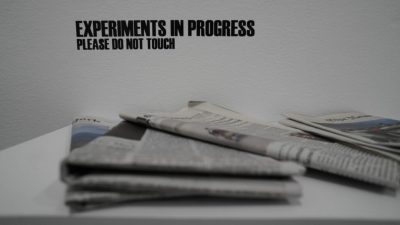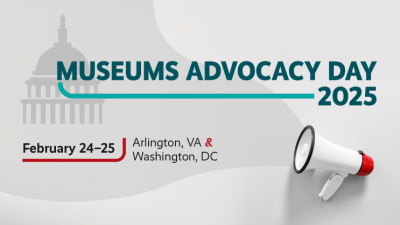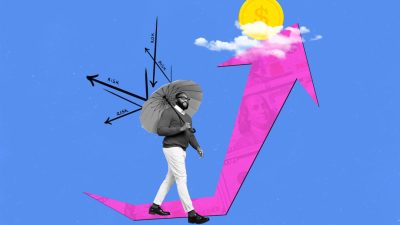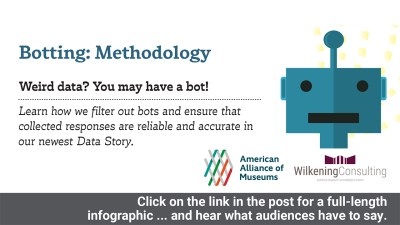This article originally appeared in Museum magazine’s January/February 2023 issue, a benefit of AAM membership.
This issue of Museum is also the 2023 edition of TrendsWatch—the 12th installment of AAM’s annual forecasting report. Produced by the Alliance’s Center for the Future of Museums, TrendsWatch examines the forces shaping the museum sector in the context of broader changes in society and explores the long-term implications of these trends. Museum people often use this report to inform planning, uncover blind spots, identify opportunities, and expand their vision of what they can achieve.
This is a critical time for museum professionals to apply a foresight lens to their planning. The COVID-19 pandemic was profoundly disruptive—not a meteoric extinction-level event (for humans, at least) but on par with previous global pandemics and world wars. There is a risk we may overestimate the long-term effect of massively disruptive events, such as the current pandemic, on all aspects of our lives—social, economic, ecological, technological, and political. Conversely, it is tempting to assume that the world will snap back, like a rubber band, to the way things used to be.
Foresight, more colloquially known as futures thinking, helps counteract the tendency to over- or underestimate the scale of these changes while providing a reminder that the legacy of the pandemic is, in large part, up to us. As we shape this legacy, there are three kinds of actions we might want to take: mitigating damage, amplifying good things, and preparing for the next disruption.
Mitigating Damage
The harm inflicted in the past three years will have a very long tail indeed. As many as 23 million Americans are suffering the effects of long COVID, and health care professionals worry about the long-term impact of the pandemic on children’s mental health. Proficiency in K–12 math and reading plummeted, with students who were already lagging experiencing the biggest losses. Researchers estimate it may take $700 billion to regain lost ground, with more equitable distribution of aid than we have seen so far. A million women left the workforce, and with good, affordable childcare even scarcer than before the pandemic, many women may be sidelined for years. Public trust in scientists, government, journalists, business leaders, and elected officials—already low—sank even further, hindering our response to the pandemic. And around the globe COVID-19 exacerbated existing inequalities in health, wealth, and education. How can we begin to heal these wounds?
Amplifying the Good
Despite the terrible toll COVID-19 has taken on the world, there were some silver linings. Government policies helped drive child poverty in the US to a record low. Some wildlife flourished during the “anthropause,” and people overall spent more time in nature (which we know is good for human health and well-being). During the pandemic a third of Americans experienced positive impacts on their relationships, including being able to spend more time with family. In the face of massive economic losses and a burgeoning labor shortage, many companies began to prioritize the well-being of their workforce, discovering the benefits of empathetic, compassionate, flexible, and supportive policies and practices. How can we nurture these beneficial practices and build on what we have learned?
Preparing for the Next Disruption
Much of the damage we suffered in the past three years stemmed from weaknesses in critical systems: health care, government, education, the social safety net. These systems were strained to the breaking point by multiple crises: the pandemic; wildfires, heat events, and storms fueled by climate change; and social unrest sparked by police violence, racism, and the legacy of oppression.
Some of the patches and tweaks we made during the pandemic worked in the short term, but the critical infrastructure of our country may need to be redesigned from the ground up. The partisan divide currently paralyzing society will make it immensely difficult to undertake such reforms, but our shared experiences during the pandemic may create common ground. New research shows that people who suffered personal harm during the pandemic (as did almost half of all Americans) are more likely to understand the roots of inequality and become advocates for equity. How can we make our organizations and our communities better able to withstand disruptions in the century to come?
The Challenge for Museums
Our sector faces the same challenges as society as a whole: to mitigate damage, amplify good things, and repair fundamental flaws in our systems. Museums face a long road to recovery. Despite widespread fears at the beginning of the pandemic, most museums survived, some thrived, but many struggle to regain lost ground. The American Association for State and Local History (AASLH) reports that attendance at history organizations climbed 75 percent from 2020 to 2021—but still hovers at half of what it was in 2019.
Museums can learn from each other the best ways to rebuild attendance, stabilize their finances, and attend to the damage staff and volunteers experienced. Museums that had already made strategic investments in digital practices seemed to compensate more quickly for pandemic disruptions. They used their digital capacity to expand their reach, find new audiences, make work safer and more efficient, and improve the visitor experience. These good practices can help museums prosper in the post-pandemic future as well.
Museums also stopped doing a lot of things they usually do, testing assumptions about what is useful or necessary. Maybe some products, programs, procedures, and policies can be left behind, making way for new and better practices. Before the pandemic, museums had just begun to confront the precarity and inequity of museum labor—the past three years have thrown those issues into stark relief. This is an opportunity for our sector to make long-term improvements in how we support the staff who make our work possible, from fair compensation to human-centered policies that create equitable access to museum jobs.
What’s Next?
This pandemic was not unforeseeable, or unforeseen, nor will it be the last profound disruption to rock the world this decade. The mission of AAM’s Center for the Future of Museums is to help you and your organization anticipate these disruptions, understand ongoing forces of change, and navigate the futures they might create. You—as an individual and collectively as an organization—are also a powerful force of change, with the ability to influence what will happen in years to come. The most important goal of foresight is to envision preferred futures—the shape and texture of the world you want to live in and leave to future generations—and take action to bring that future into being.
Warmest regards from that brighter future,
Elizabeth Merritt
Vice President, Strategic Foresight, and Founding Director, Center for the Future of Museums, American Alliance of Museums
What Is TrendsWatch?
TrendsWatch is the annual forecasting report produced by the Center for the Future of Museums, the American Alliance of Museums’ think tank and idea laboratory for the museum field. Each edition is built on a year’s worth of news gathering and analysis, research, and conversations.
This edition of TrendsWatch, the 12th in the series, appears as the January/February issue of Museum magazine. A PDF copy of the report will be available from the TrendsWatch landing page on the AAM website at the end of March 2023. You can find dozens of embedded links to original sources for the information referenced in this text in the digital issue of Museum and in the PDF.
The text for this report was written by CFM’s director, Elizabeth Merritt, with input and advice from many people inside and outside the museum sector. We encourage you to join this conversation. Please share your thoughts and questions by:
- Tagging @futureofmuseums on Twitter or @emerritt@glammr.us on Mastodon.
- Posting to the Alliance discussion forum Museum Junction. (Directors are welcome to join the CEO Forum on Museum Junction.)
- Submitting guest posts to the CFM blog.
- Emailing CFM at emerritt@aam-us.org.
Elizabeth and her colleagues are available to support your work via speaking engagements, workshops, moderating discussions, and consulting. For more information on those services and to request our help, visit the Alliance Advisors and Speakers Bureau.









Comments